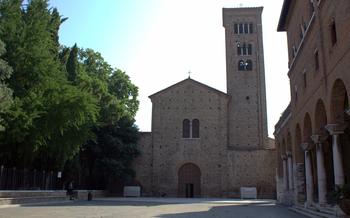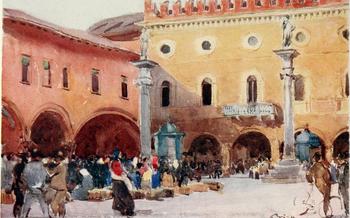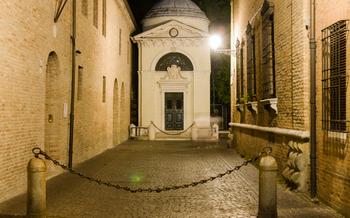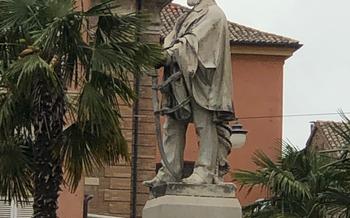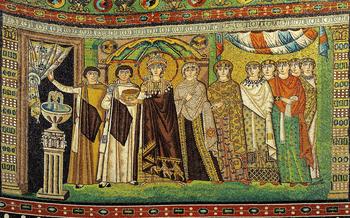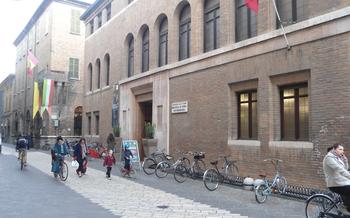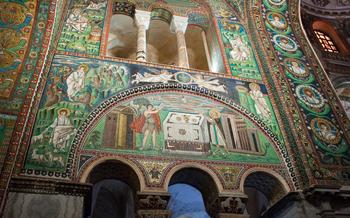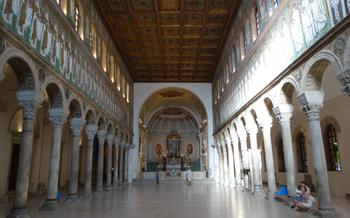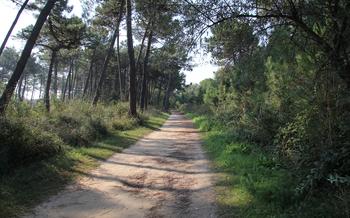
Via Cavour
- Introduction
- Historical Significance of Via Cavour
- Architectural Highlights
- Churches and Basilicas
- Museo Nazionale di Ravenna
- Tombs of Dante and Galla Placidia
- Shopping and Dining
- Events and Festivals
- Art Galleries and Studios:
- Walking Tours and Itineraries
- Photography Opportunities: Capturing the Essence of Via Cavour Through the Lens
- Via Cavour, a vibrant and historically rich street, is a photographer's paradise. The street's architectural wonders, historical landmarks, and vibrant street life offer endless opportunities to capture stunning photographs.
- The intricate facades of the buildings, with their decorative elements and architectural styles, create a picturesque backdrop for your shots. Capture the grandeur of the Teatro Alighieri, with its elegant columns and arched windows, or the Biblioteca Classense, with its impressive neoclassical architecture.
- Don't miss the chance to photograph the tombs of Dante and Galla Placidia, which tell stories of history and culture through their intricate mosaics and architectural details.
- To capture the essence of Via Cavour's vibrant street life, take advantage of the lively atmosphere and photograph the locals going about their daily lives, the street vendors displaying their wares, or the musicians performing in the piazzas.
- The best time for photography on Via Cavour is during the golden hours, when the warm light bathes the street in a magical glow. Experiment with different angles and perspectives to create unique compositions, and use the play of light and shadow to add depth and drama to your shots.
- Whether you're a professional photographer or simply passionate about capturing memories, Via Cavour offers a plethora of opportunities to create beautiful and evocative photographs. So bring your camera, embrace your creativity, and let the street be your canvas.
- Insider Tip: Discover the Hidden Courtyard of Palazzo Rasponi
Introduction
Ravenna, a captivating city in Italy's Emilia-Romagna region, holds a prominent place on the UNESCO World Heritage list, owing to its exceptional collection of well-preserved late antique and early medieval monuments. Its strategic geographical position, situated on the Adriatic coast, has shaped its rich history and cultural heritage. Ravenna served as the capital of the Western Roman Empire during the 5th century and later became the capital of the Byzantine Exarchate, leaving an indelible mark on its architecture, art, and culture. Its significance as a center of power and influence is reflected in the magnificent buildings, mosaics, and monuments that adorn its streets, making it a captivating destination for history buffs, art enthusiasts, and travelers seeking unique cultural experiences.
Historical Significance of Via Cavour
Via Cavour's historical significance is deeply intertwined with the development and growth of Ravenna. During the Roman Empire, it served as a vital artery connecting the city to the port and played a crucial role in trade and commerce. In the Middle Ages, it became the main thoroughfare for pilgrims traveling to the city's many religious sites, contributing to Ravenna's reputation as a center of Christianity.
Throughout history, Via Cavour has witnessed numerous transformations, reflecting Ravenna's evolving urban landscape. In the 16th century, the street underwent significant renovations under the rule of the Papal States, resulting in the construction of several impressive palaces and churches. In the 19th century, it became a hub for commercial activities, with the establishment of shops, markets, and trading centers, solidifying its position as a vibrant commercial district.
The street's economic significance has been instrumental in shaping its unique character. Over the centuries, merchants, artisans, and traders have converged on Via Cavour, creating a diverse and dynamic atmosphere. This economic vitality has contributed to the street's architectural richness, as many of the buildings along its length showcase elaborate facades and intricate details, reflecting the wealth and prosperity that flowed through this historic thoroughfare.
Architectural Highlights
Via Cavour stands out for its rich architectural tapestry, embodying various styles from different eras. Take a leisurely stroll along this street, and you'll encounter an array of buildings that showcase a harmonious blend of grandeur and history.
One of the predominant architectural styles is neoclassicism, characterized by its clean lines, symmetrical facades, and imposing columns. Notable examples include the elegant Palazzo Rasponi dalle Teste and the majestic Palazzo Merlato, both adorned with intricate carvings and decorative elements. These buildings create a sense of grandeur and sophistication along the street.
In contrast, you'll also find buildings that reflect the Gothic style, particularly the Church of Sant'Apollinare Nuovo. This striking edifice boasts stunning stained glass windows, intricate mosaics, and an impressive bell tower. The Gothic style adds a touch of medieval charm to Via Cavour, transporting visitors back in time.
Moreover, Via Cavour is home to several historical landmarks, including the Torre dell'Orologio, a 13th-century clock tower that stands as a symbol of Ravenna's rich history. Don't miss the Palazzo Comunale, the city hall, which showcases a harmonious blend of Gothic and Renaissance architectural elements. These historical landmarks add depth and character to the street, making it a living testament to Ravenna's storied past.
Finally, Via Cavour is also known for its artistic influence. Several buildings along the street are adorned with beautiful frescoes and sculptures, reflecting the artistic heritage of the city. Take the time to admire the intricate details and vibrant colors that adorn these buildings, which add a touch of artistic flair to the street.
Churches and Basilicas
Via Cavour is home to several significant churches and basilicas, each possessing unique architectural features and religious importance. The most notable among them is the Basilica di San Vitale, an early Christian masterpiece that dates back to the 6th century. With its octagonal shape and intricate mosaics depicting scenes from the Bible, San Vitale represents the pinnacle of Byzantine architecture in Ravenna.
Another must-visit basilica is Sant'Apollinare Nuovo, which boasts a series of stunning mosaics depicting the life of Jesus Christ and the procession of saints. This basilica is known for its vibrant colors and expressive figures, showcasing the artistic mastery of the early Christian period.
For those interested in exploring further, the Basilica di San Giovanni Evangelista offers a glimpse into the early Christian era. Founded in the 5th century, this basilica features beautiful mosaics and a unique circular bell tower, making it a hidden gem among Ravenna's religious landmarks.
These churches and basilicas along Via Cavour are not merely architectural marvels but also serve as a testament to Ravenna's rich religious heritage. They offer visitors a profound insight into the city's spiritual and cultural significance, making them essential destinations for anyone seeking a deeper connection with Ravenna's past.
Museo Nazionale di Ravenna
The Museo Nazionale di Ravenna is a treasure trove of artifacts and artworks that narrate the rich history of Ravenna from its ancient origins to the present day. Housed in a former Benedictine monastery, the museum's collection spans various eras and civilizations that have left their mark on the city.
Visitors can embark on a journey through time as they explore the museum's diverse exhibits. Among the highlights are the remarkable collection of Byzantine mosaics, which showcase the city's renowned artistic heritage. These intricate and colorful mosaics depict religious scenes, historical events, and mythological tales, offering a glimpse into the cultural and spiritual life of Ravenna during the Byzantine era.
In addition to the mosaics, the museum houses an impressive collection of sculptures, paintings, ceramics, and other artifacts that shed light on Ravenna's artistic and cultural development. Visitors can admire works by renowned local artists, such as Guido Reni and Luca Longhi, as well as significant pieces from the Middle Ages and the Renaissance.
The Museo Nazionale di Ravenna is not merely a repository of artifacts; it is a place where history comes alive. Through its comprehensive collection and engaging exhibitions, the museum provides visitors with a deeper understanding of Ravenna's past and its enduring legacy as a cultural and artistic hub.
Educational Programs:
The museum also offers a range of educational programs and activities designed to engage visitors of all ages. Guided tours, workshops, and lectures provide insights into the museum's collection and the history of Ravenna. These programs aim to foster a greater appreciation for the city's cultural heritage and encourage lifelong learning.
Cultural Significance:
The Museo Nazionale di Ravenna holds immense cultural significance as it preserves and showcases the artistic treasures of Ravenna, a city renowned for its rich history and diverse cultural influences. The museum's collection serves as a testament to the city's enduring legacy as a center of art and culture, attracting visitors from around the world to explore its remarkable treasures.
Tombs of Dante and Galla Placidia
In the heart of Ravenna, near the Basilica of San Francesco, lies the hallowed resting place of Dante Alighieri, the legendary poet who immortalized the city in his masterpiece, The Divine Comedy. Dante's tomb, a simple yet poignant monument, stands as a testament to his enduring legacy. Pilgrims from around the world come to pay homage to the master of Italian literature, seeking inspiration and solace within the walls of his final resting place.
Just a short distance away, nestled amidst lush gardens, lies another remarkable tomb, that of Galla Placidia, the Roman empress who ruled Ravenna in the 5th century. Constructed during her lifetime as a mausoleum for herself and her family, the Tomb of Galla Placidia is a breathtaking example of early Christian architecture. Its exquisite mosaics, depicting scenes from the Bible and the afterlife, have captivated visitors for centuries, earning it the designation of a UNESCO World Heritage Site.
The historical significance of these tombs is immeasurable. Dante Alighieri, revered as the father of the Italian language, left an indelible mark on world literature through his poetic genius. Galla Placidia, a powerful and influential figure in her own right, played a pivotal role in shaping the political and cultural landscape of Ravenna during the late Roman Empire. Their tombs, standing as silent witnesses to their extraordinary lives, offer a glimpse into the rich history and cultural heritage of this ancient city.
Shopping and Dining
Via Cavour is a shopper's paradise, with a diverse range of boutiques, shops, and specialty stores offering unique local products and handmade crafts. From elegant clothing and accessories to traditional ceramics and mosaics, there's something to suit every taste and budget.
For those seeking a culinary adventure, Via Cavour is a foodie's haven. From traditional trattorias serving authentic Italian cuisine to modern bistros offering innovative fusion dishes, there's a restaurant or cafe to satisfy every palate. Be sure to sample the local specialties, such as piadina, a flatbread filled with prosciutto, cheese, and arugula, or cappellacci di zucca, a type of pasta filled with pumpkin and topped with a butter and sage sauce.
For a truly authentic experience, visit the bustling markets that take place along Via Cavour on certain days of the week. Here, you can find fresh produce, local cheeses, cured meats, and a variety of handmade goods from local artisans. Whether you're looking for a unique souvenir or simply want to soak up the lively atmosphere, the markets are a must-visit.
Events and Festivals
Via Cavour and Ravenna come alive with a vibrant calendar of events and festivals throughout the year, reflecting the city's rich cultural heritage and traditions. From annual celebrations to religious processions and local fairs, there's always something to experience along this historic street.
One of the most anticipated events is the Ravenna Festival, an international festival of classical music, opera, and dance held every summer. The festival attracts renowned artists from around the world and offers a diverse program of performances in enchanting venues, including the Teatro Alighieri and the Basilica of San Vitale.
For a taste of local traditions, don't miss the Palio di San Romolo, a historical pageant held in July to commemorate the city's patron saint. The event features a colorful procession through the streets, showcasing traditional costumes, music, and performances that bring the city's history to life.
Religious celebrations are also a significant part of Ravenna's cultural calendar. The Feast of the Assumption in August is a major religious holiday marked by solemn processions and special masses in the city's churches.
Throughout the year, Via Cavour hosts various markets and fairs, offering a chance to experience the local flavors and traditions. The Christmas Market fills the street with festive stalls selling handmade gifts, decorations, and local delicacies, creating a magical atmosphere during the holiday season.
Whether you're a history buff, a music lover, or simply seeking an authentic Italian experience, Via Cavour's events and festivals offer a glimpse into the vibrant cultural tapestry of Ravenna, inviting you to immerse yourself in the city's traditions and celebrations.
Art Galleries and Studios:
Via Cavour is home to a vibrant art scene, with several art galleries and studios showcasing the works of local and international artists. These venues provide a platform for emerging talents and established artists alike, offering visitors a glimpse into the creative energy of Ravenna.
The art galleries and studios along Via Cavour are known for their diverse exhibitions, which range from contemporary paintings and sculptures to photography, ceramics, and mixed media. Visitors can admire the works of local artists, who draw inspiration from Ravenna's rich history and cultural heritage.
Some of the notable art galleries include the Galleria d'Arte Contemporanea, which features rotating exhibitions of modern and contemporary art, and the Galleria dell'Accademia, which showcases the works of established Italian and international artists. These galleries often organize workshops, conferences, and artist talks, providing opportunities for visitors to engage with the local art community.
Walking Tours and Itineraries
To truly soak in the essence of Via Cavour and its treasures, consider embarking on a leisurely walking tour. Start at the northern end, where the street intersects with Piazza del Popolo. Take a moment to admire the imposing presence of the basilica of San Vitale and the elegant facade of the Teatro Alighieri. Continue south, noting the architectural details and historical landmarks along the way.
Pause at the Biblioteca Classense to delve into the world of ancient manuscripts and rare books. Admire the impressive collection of artifacts and artworks at the Museo Nazionale di Ravenna, gaining insights into the city's rich history. Pay homage to the renowned poet Dante Alighieri at his tomb, and marvel at the stunning mosaics that adorn the Mausoleum of Galla Placidia.
Immerse yourself in the vibrant atmosphere of Piazza del Popolo, the heart of Ravenna's social and cultural life. Take a break at one of the many cafes or restaurants, savoring local delicacies as you watch the world go by. Continue your stroll, discovering hidden gems and local favorites tucked away along the side streets.
The walking tour can take anywhere from two to three hours, depending on your pace and the amount of time you spend exploring the attractions. Wear comfortable shoes and bring a camera to capture the many photo-worthy moments. Guided tours are also available for those who prefer a more structured experience.
Photography Opportunities: Capturing the Essence of Via Cavour Through the Lens
Via Cavour, a vibrant and historically rich street, is a photographer's paradise. The street's architectural wonders, historical landmarks, and vibrant street life offer endless opportunities to capture stunning photographs.
The intricate facades of the buildings, with their decorative elements and architectural styles, create a picturesque backdrop for your shots. Capture the grandeur of the Teatro Alighieri, with its elegant columns and arched windows, or the Biblioteca Classense, with its impressive neoclassical architecture.
Don't miss the chance to photograph the tombs of Dante and Galla Placidia, which tell stories of history and culture through their intricate mosaics and architectural details.
To capture the essence of Via Cavour's vibrant street life, take advantage of the lively atmosphere and photograph the locals going about their daily lives, the street vendors displaying their wares, or the musicians performing in the piazzas.
The best time for photography on Via Cavour is during the golden hours, when the warm light bathes the street in a magical glow. Experiment with different angles and perspectives to create unique compositions, and use the play of light and shadow to add depth and drama to your shots.
Whether you're a professional photographer or simply passionate about capturing memories, Via Cavour offers a plethora of opportunities to create beautiful and evocative photographs. So bring your camera, embrace your creativity, and let the street be your canvas.
Insider Tip: Discover the Hidden Courtyard of Palazzo Rasponi
Tucked away along Via Cavour, an unassuming entrance leads to a hidden gem—the enchanting courtyard of Palazzo Rasponi. This secret spot is a serene oasis amidst the bustling city, where visitors can escape the crowds and soak in the tranquility. The courtyard is adorned with elegant arches, lush greenery, and a charming fountain, creating a picturesque setting that transports you back in time.
Take a moment to pause and savor the tranquility of this hidden retreat. Listen to the gentle sound of water trickling from the fountain, admire the intricate architectural details, and let the serenity wash over you. As you wander through the courtyard, imagine the stories that these walls could tell, of the noble families who once resided here and the events that unfolded within these historic grounds.
Whether you seek a moment of solitude or a unique backdrop for your photographs, the hidden courtyard of Palazzo Rasponi offers a glimpse into the rich history and hidden treasures of Ravenna. Don't miss this opportunity to explore beyond the main tourist attractions and discover the city's secret charm.
